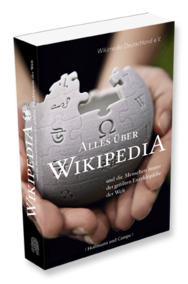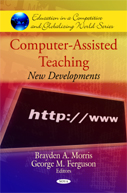 Aufgrund des 10-jährigen Bestehens der Wikipedia, wurde ich eingeladen aufgrund unserer Forschungsarbeiten eine Anekdote, eine kleine Geschichte oder sonstiges zu verfassen. Ich habe mich entschlossen ein paar Gedanken zu „Wikipedia: Ein Vorreiter für die Bildungslandschaft?“ festzuhalten. Der Beitrag ist [hier] frei zugänglich. Das Buch selbst „Alles über Wikipedia“ kann man ab sofort kaufen, aber es sind viele Artikel dort aus Platzgründen nicht abgedruckt.
Aufgrund des 10-jährigen Bestehens der Wikipedia, wurde ich eingeladen aufgrund unserer Forschungsarbeiten eine Anekdote, eine kleine Geschichte oder sonstiges zu verfassen. Ich habe mich entschlossen ein paar Gedanken zu „Wikipedia: Ein Vorreiter für die Bildungslandschaft?“ festzuhalten. Der Beitrag ist [hier] frei zugänglich. Das Buch selbst „Alles über Wikipedia“ kann man ab sofort kaufen, aber es sind viele Artikel dort aus Platzgründen nicht abgedruckt.
[event] Neue Publikationen für die Hochschullehre
 Es freut uns, dass wir – das iUNIg-Team – eine neue Veranstaltung ankündigen können: Neue Publikationen für die Hochschullehre. Am 10. Oktober 2011 stellen Prof. Baumgartner und Elke Lackner ihre neuen Bücher an der TU Graz vor. Ich selbst werde das Thema aufgreifen ob das Lehrbuch in Zukunft überhaupt noch ein Buch im klassischen Sinne sein wird und dabei auch über die Erfahrungen mit L3T reden.
Es freut uns, dass wir – das iUNIg-Team – eine neue Veranstaltung ankündigen können: Neue Publikationen für die Hochschullehre. Am 10. Oktober 2011 stellen Prof. Baumgartner und Elke Lackner ihre neuen Bücher an der TU Graz vor. Ich selbst werde das Thema aufgreifen ob das Lehrbuch in Zukunft überhaupt noch ein Buch im klassischen Sinne sein wird und dabei auch über die Erfahrungen mit L3T reden.
Wir bitten um eine Anmeldung zu dieser ansonst kostenfreien Veranstaltung und ich würde mich freuen beim anschließenden Buffet über das Thema weiter zu diskutieren. Weitere Details findet man auf der iUNIg-Homepage [Link] bzw. im Folder [.pdf].
[publication] Is the iPhone a Ubiquitous Learning Device? A First Step Towards Digital Lecture Notes
Our contribution „Is the iPhone a Ubiquitous Learning Device? A First Step Towards Digital Lecture Notes“ to the book „Ubiquitous Learning – Strategies for Pedagogy, Course Design and Technology“ is now published and as draft version online available.
Abstract:
Computing conquers to mobile devices very quickly. Students are among the first to adopt to it even accelerate this progress. This opens new possibilities for teachers to reach and interact with their students but also increases the amount of information a learner has to cope with. This paper describes the idea and prototypical implementation of a method to use the Web and digital devices to ease the digitalization of lecture notes and thus accessibility of information gathered in the course of learning.
Klicken Sie auf den unteren Button, um den Inhalt von www.scribd.com zu laden.
Reference: Ebner, M., Billicsich, T. (2011). Is the iPhone a Ubiquitious Learning Device? A First Step Towards Digital Lecture Notes. Kidd, T. T. & Chen, I. (Ed.). Ubiquitous Learning Strategies for Pedagogy, Course Design and Technology. Information Age Publishing. p. 137-151
[l3t] Call for photos and illustrations
We need for our book-project „Teaching and Learning with Technologies“ (l3t) pictures and illustrations for each chapter. Therefore we started a Flickr-group a couple of months ago, where we are asking for appropriate pictures under a creative-commons licenses. Please become a member and share your photos with an exciting community on Technology Enhanced Learning.
A general introduction of the project in English:
[L3T] L3T goes Mr. Wong
![]() Nachdem vermehrt der Wunsch aufgetreten ist Linklisten für Buchkapiteln des L3T Projektes ablegen zu können, haben wir entschieden eine L3T Gruppe bei Mr. Wong hierfür anzulegen. Man kann jederzeit der Gruppe beitreten und Links dazu speichern. Soll die Zuordnung gezielt für ein Kapitel erfolgen, dann bitten wir um die Verwendung eines speziellen Tag in der Form l3t_XXX (XXX ist das Kürzel für das Kapitel, z.B. l3t_lms für Lernmanagementsystemte), damit man schnell die entsprechenden Links finden kann (hier der Link zu dieser Liste).
Nachdem vermehrt der Wunsch aufgetreten ist Linklisten für Buchkapiteln des L3T Projektes ablegen zu können, haben wir entschieden eine L3T Gruppe bei Mr. Wong hierfür anzulegen. Man kann jederzeit der Gruppe beitreten und Links dazu speichern. Soll die Zuordnung gezielt für ein Kapitel erfolgen, dann bitten wir um die Verwendung eines speziellen Tag in der Form l3t_XXX (XXX ist das Kürzel für das Kapitel, z.B. l3t_lms für Lernmanagementsystemte), damit man schnell die entsprechenden Links finden kann (hier der Link zu dieser Liste).
Wer Mr. Wong noch nicht verwendet hat, hier ein guter Link zu den zusätzlichen Möglichkeiten mit Firefox Toolbar etc.
[publication] New Forms of and Tools for Cooperative Learning with Social Software in Higher Education
 Sandra and I wrote a summary of different tools and forms of cooperative learning with Social Software in higher education. It was just published in the book „Computer-Assisted Teaching: New Developments“ (ed. by Brayden A. Morris and George M. Ferguson).
Sandra and I wrote a summary of different tools and forms of cooperative learning with Social Software in higher education. It was just published in the book „Computer-Assisted Teaching: New Developments“ (ed. by Brayden A. Morris and George M. Ferguson).
Our abstract:
Since the new generation of Internet technology, called Web 2.0, has been introduced, a change of how users are dealing with the World Wide Web has been get into going. If access to the Web is available, today nearly anyone can actively participate and communicate online. Of course this recent evolution of the Web influences also the field of education. Former e-learning was mainly characterized by the use of content offered within learning management systems. Nowadays so called “Social Software” enables new possibilities and didactical approaches. In this chapter we give a short overview of how Social Software can support cooperative learning and how new technologies can enhance higher education in a meaningful new way. After a short introduction to the basics of cooperative learning different Social Software applications are classified and described. Practical examples are presented to show the general usage. In the end we conclude that these technologies have great impact on teaching and learning, as it will help to enhance education at universities.
Within the paper, we distinguished different forms of Social Software:
Social Software can be distinguished concerning their main purposes
- Social presence and communication including discussion forums, Web chats, (micro-) blogging, (micro-) podcasting, and live streaming;
- Collaborative development including tools that allow a collaborative work and development as the Wiki technology; or
- Collaborative enrichment of content such as social bookmarking, social tagging, and rating.
Then we went on with a short description of different teaching settings (formally organised learning), where cooperative learning can be used:
1. Distance learning setting
The learners are distributed and do not meet in reality before and while learning and working together. The online communication is not always, but often asynchronous;
2. Blended learning setting
The learners meet in reality and additionally online but normally not parallel. The online communication usually is asynchronous;
3. Classroom group work setting – with 10 to 25 learners
Every learner additionally and parallel to “real” communication participates through networked computers or mobile phones on the group interaction
4. Lecture hall learning setting
The learners use networked computers or mobile phones to facilitate interaction and feedback loops in big groups of more than 40 people parallel to a (interactive) lecture.
In the paper we list tools and their usage and how it already worked (or not) within cooperative learning settings. We came to the conclusion (amongst other aspects!!):
The use of technology in education strongly depends on the questions how we can improve the quality of education and how we can benefit from it. For example, digital collaboration with the help of Wiki systems leads to new possibilities that had not been imaginable within a paper-based learning scenario. Furthermore tagging enhances learner’s content in a new meaningful way and makes the content shareable und reusable. Micro-blogging as described in previous chapters must be seen as a complete new form of communication – talking to a cloud, without knowing if anyone will read or even react to it.
As cooperative learning is very often a part of open educational practices, where learners have the possibilities to organize their own learning within their groups as active partners, changes of learning and teaching behavior is not only a matter of such new tools. Also the existing learning culture within the institution or the teaching abilities and attitudes of lectures are (amongst others) crucial aspects of teaching in higher education that has to be taken into account for a successful implementation or usage of such new tools for cooperative learning (cf. Schaffert, 2009).
Additionally, we have to bear in mind that such tools are not built especially for learning settings. It is up to the researchers and every single user to find out whether learners can benefit from it or not. (…)
Reference: Schaffert, Sandra & Ebner, Martin (2010). New Forms of and Tools for Cooperative Learning with Social Software in Higher Education. In: Brayden A. Morris & George M. Ferguson (Ed.), Computer-Assisted Teaching: New Developments. Nova Science Pub, p. 151-165.
[video] Text 2.0
Egal wie man es nennt, aber die Idee Eye Tracking mit Buch lesen zu verbinden ist unglaublich spannend:
Hier gibt es weitere Details.
Soll ich das empfehlen ….
oder doch lieber einem System überlassen? Ach was, das Buch „Empfehlungen im Web: Konzepte und Realisierungen“ ist ab sofort erhältlich und sollte gelesen werden, wenn man sich mit Recommendation Systemen beschäftigen will. [Amazon Link].
Warum eigentlich in jeder Gummibärchen Packung die Farbe rot vertreten ist, wird hier gezeigt:
Hier gibt es mehr Details.
Free e-Learning Books
Bin soeben auf eine sehr gute Liste gestoßen:
Ich denke da findet man sicher die ein oder andere interessante Unterlage – viel Spaß.
[video] Augmented Reality by Hitlab
Es ist zwar noch in der Realität umgesetzt, aber das Video zeigt sehr schön was Augmented Reality in Zukunft im Lehr- und Lernbereich leisten kann. Bin wirklich gespannt wann wir die ersten Realeinsätze einmal miterleben können:
